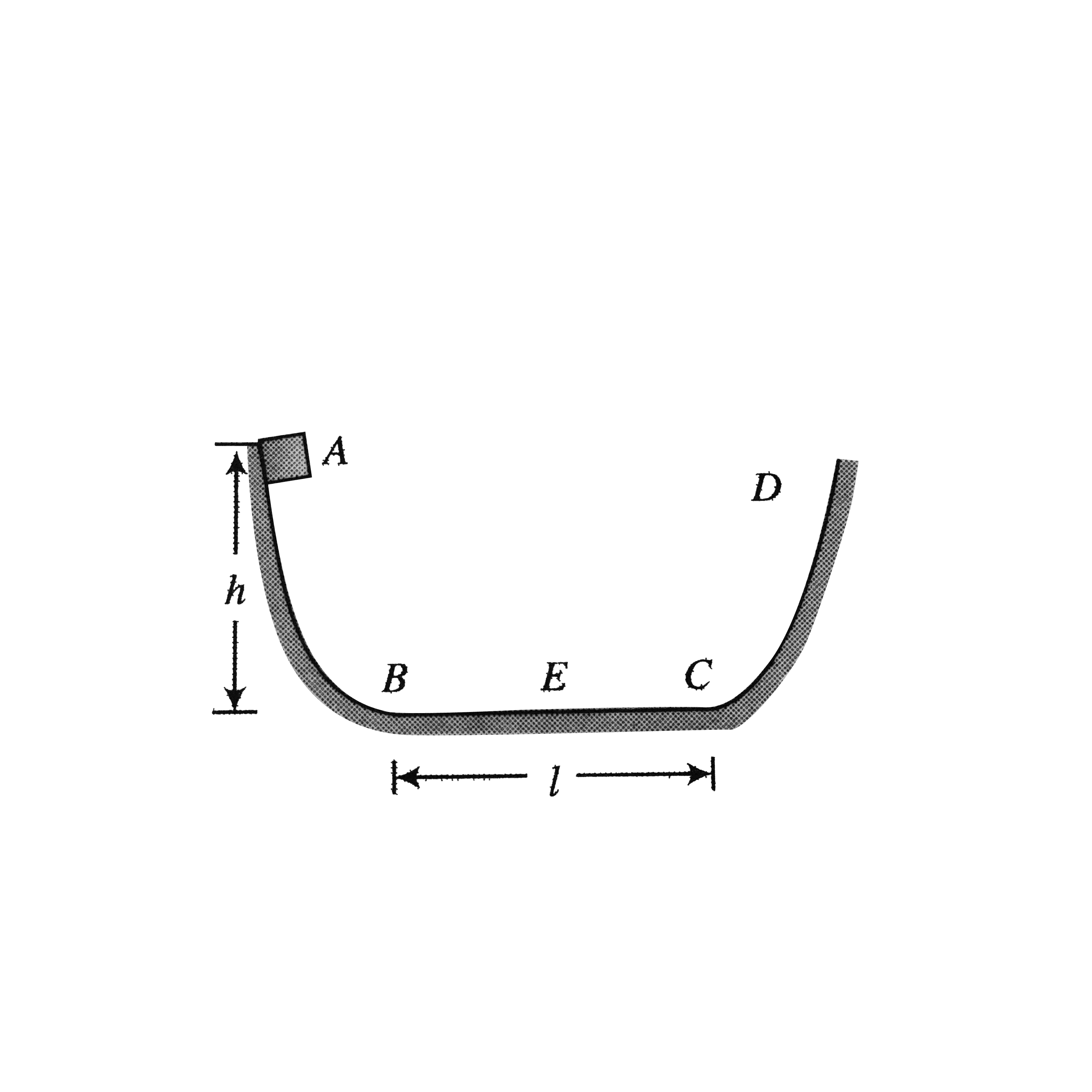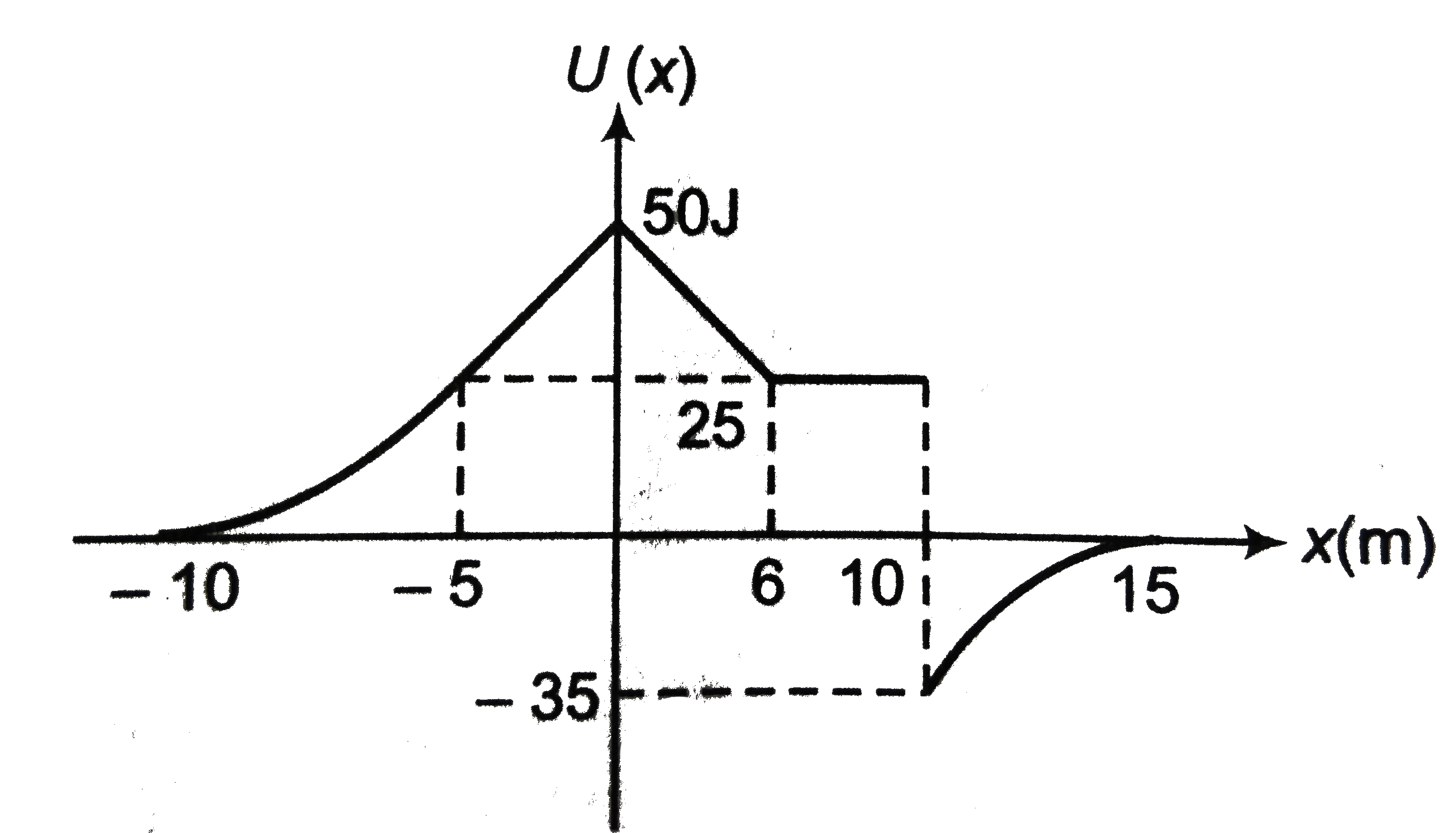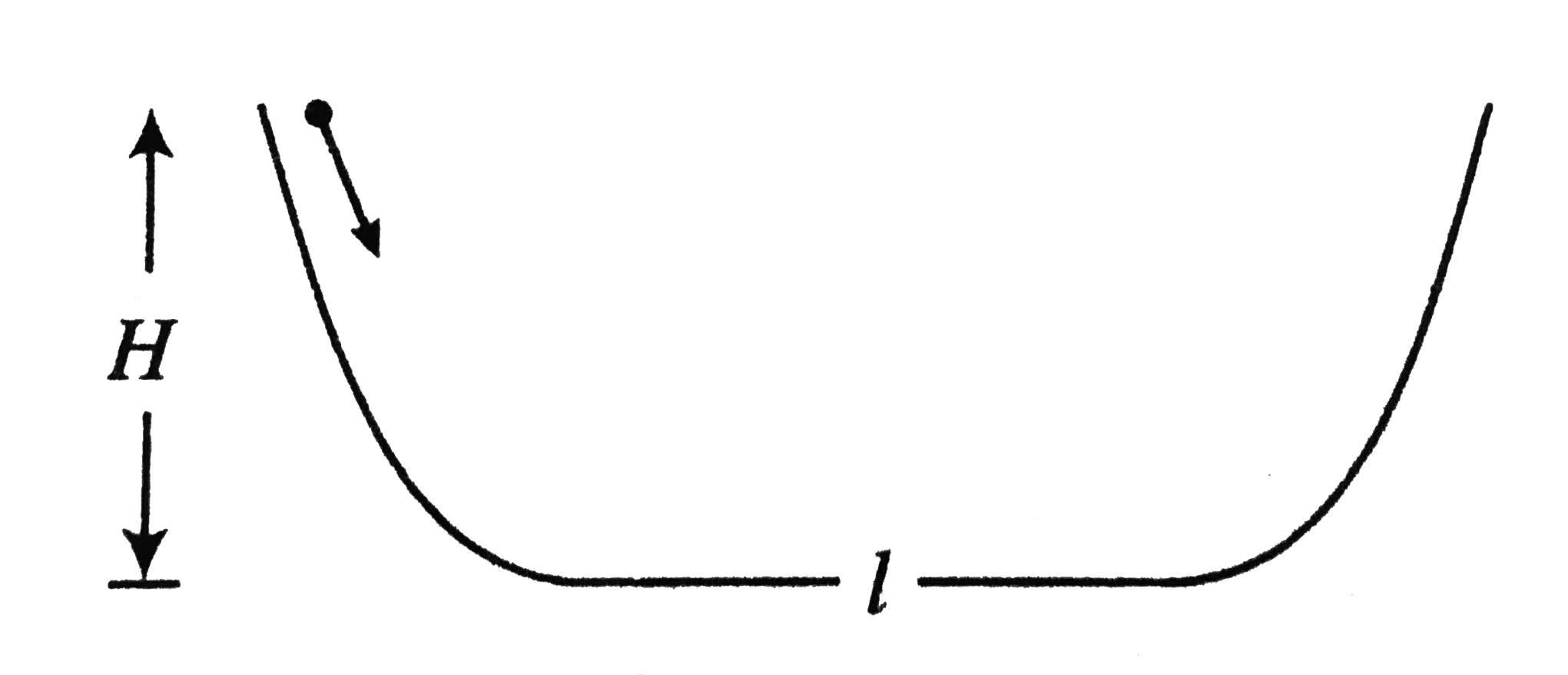A particle slides along a track with elevated ends and a flat central part as shown in figure. The flat part has a length l=3m. The curved portions of the track are frictionless. For the flat part, the coefficient of kinetic friction is μk=0.2. The particle is released at point A which is at height h=1.5m above the flat part of the track. Where does the particle finally come to rest?

The correct Answer is:A
As initial mechanical energh of the block is mgh and final is zero, so loss in mechanical energy =mgh. This mechanical energy is lost in doing work against friction in the flat part,
So, loss in mechanical energy = work done against friction
or mght=μmgd i.e. d=hμ=1.50.2=7.5m
After starting from, B, the block will reach C and then will rise up till the remaining (KE) at (C) is converted into potential inergy. It will then again descend and at C will have the some value as it had when ascending, but now it will move from C to B. The same will be repeated and finally the block will come to rest at E such that
BC+CB+BE=7.5
or 3+3+BE=7.5
i.e. BE=1.5
So, the block comes to rest at the centre of the flat part.
Topper's Solved these Questions
- WORK, ENERGY & POWERBOOK - DC PANDEYCHAPTER - WORK, ENERGY & POWEREXERCISE - TYPE2
1 Videos
- WORK, ENERGY & POWERBOOK - DC PANDEYCHAPTER - WORK, ENERGY & POWEREXERCISE - Miscellaneous Example
6 Videos
- WORK, ENERGY & POWERBOOK - DC PANDEYCHAPTER - WORK, ENERGY & POWEREXERCISE - Level 2 Comprehension Based
2 Videos
- WAVE MOTIONBOOK - DC PANDEYCHAPTER - WAVE MOTIONEXERCISE - Integer Type Question
11 Videos
- WORK, ENERGY AND POWERBOOK - DC PANDEYCHAPTER - WORK, ENERGY AND POWEREXERCISE - MEDICAL ENTRACES GALLERY
33 Videos
Similar Questions
In the figure sown in the concept, find
(a) Equilbrium extension x∘(=AB)
(b) Maximum extension xm(=AC)
(c)Maximum speed at point B.
View SolutionA small mass m starts from rest and slides down the smooth spherical surface of F. Assume zero potential energy at the top. Find
(a) the change in potential energy,
(b) the kintic energy,
(c) the speed ot the mass as a function of the angle θ made by the radius through the mass with the vertical.
View SolutionThe figure shows the variation of potential energy of a particle as a funcation pf x, the x-coordination of the region. It has been assumed that potential energy depends only on x. For all other values x,U is zero. i.e. forx<−10 and x>15,U=0.

If total mechanical energy of the particle is 25J, then it can found in the region
View SolutionTwo wires of same material of radii 2r and r are welded together end to end The combination is used as a sonometer wire and is kept under tension T. The welded point lies midway between the bridges. What wil be the ratio of the number of loops formed in the wires, such that the joint is node when the stationary waves are set up in the wire?
View SolutionA body of mass 1kg begins to move under the action of a time dependent force →F=(2tˆI+3t2ˆj)N, where ˆi and ˆj are unit vectors along x-and y-axes. What power will be developed by the force at the time t ?
View SolutionA particle slides along a track with elevated ends and a flat central part as shown in figure. The flat part has a length l=3m. The curved portions of the track are frictionless. For the flat part, the coefficient of kinetic friction is μk=0.2. The particle is released at point A which is at height h=1.5m above the flat part of the track. Where does the particle finally come to rest?

View SolutionA particle of mass m slides along a curved-flat-curved track. The curved portions of the track are smooth. If the particle is released at the top of one of the curved portions, the particle comes to rest at flat portion of length l and of μ=μkinetic after covering a distance of

View SolutionA track has two inclined surface AB and DC each of length 3 m and angle of inclination of 30∘ with the horizontal and a central horizontal part of length 4m shown in figure. A block of mass 0.2 kg slides from rest from point A. The inclined surfaces are frictionless. If the coefficient of friction between the block and the horizontal flat surface is 0.2, where will the block finally come to rest ? [in 10−1m]

View SolutionConsider a frictionless rampp on which a smooth object is made to slide down from an initial height h . The distance d necessary to stop the object on a flat track ( of coefficient of friction μ ) , kept at the ramp end is
View SolutionConsider a frictionless rampp on which a smooth object is made to slide down from an initial height h . The distance d necessary to stop the object on a flat track ( of coefficient of friction μ ) , kept at the ramp end is
View Solutionएक समतल तरंगगाग्र निम्न में से किसका भाग है ?
View SolutionConsider a frictionless ramp on which a smooth object is made to slide down from an initial height 'h'. The distance 'd' necessary to stop the object on a flat track of coefficient of friction 'μ.'), kept at the ramp end is
View SolutionA particle slides along a track with elevated ends and a flat central part as shown in Fig. The flat part has a length l = 3.0 m. The curved portions of the track are frictionless. For the flat part the coefficient of kinetic friction is mu_(k)=0.20 , the particle is released at point A which is at height h = 1.5 m above the flat part of the track. Where does the particle finally come to rest ?
View SolutionA particle slides along a track with elevated ends and a flat central part as shown in Fig. The flat part has a length l = 3.0 m. The curved portions of the truck are fricionless. For the flat part the coefficient of kinetic friction is mu_(k) = 0.20, the particle is released at point A which is at height h = 1.5 m above the flat part of the track. Where does the particle finally come to rest ?
View SolutionA track has two inclined surface AB and DC each of length 3 m and angle of inclination of 30∘ with the horizontal and a central horizontal part of length 4m shown in figure. A block of mass 0.2 kg slides from rest from point A. The inclined surfaces are frictionless. If the coefficient of friction between the block and the horizontal flat surface is 0.2, where will the block finally come to rest ? [in 10−1m]

View Solution
